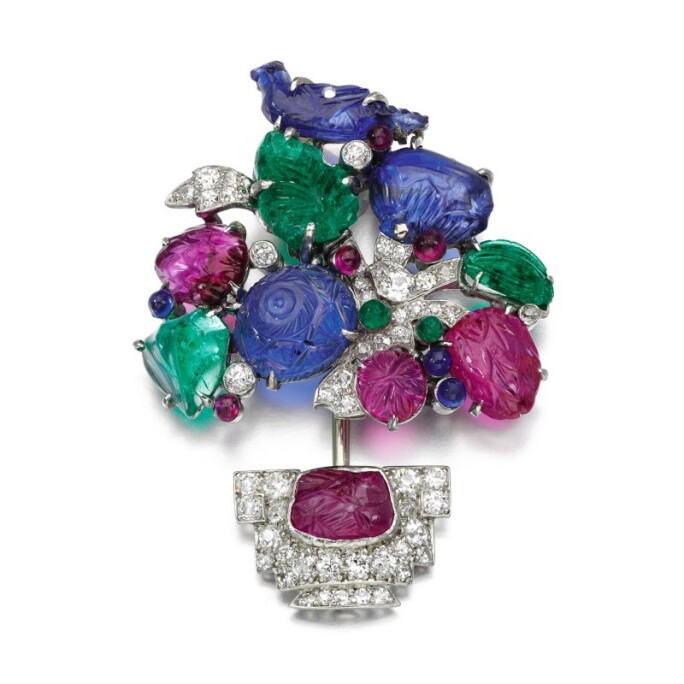This extraordinary group of jewels (lots 335-338), with their profusion of multicoloured carved gemstones, immediately brings to mind a revolutionary and much-celebrated style created by Cartier, often known as ‘Tutti Frutti’.

Estimate 40,000 - 60,000 GBP
Initially referred to as ‘Pierres de couleur’ (simply ‘coloured stones’) or ‘Hindou’, these jewels were built around the carved rubies, emeralds and sapphires often found in Indian pieces. While it reached its zenith in the mid 1920s, the style was in gestation as early as 1901, when Cartier was commissioned by Queen Alexandra to remount some of her jewels in an Indian style. Later, during a trip to India in 1911, Jacques Cartier was asked by the Maharajahs of Patiala and Kapurthala to do the reverse – to remount their own Indian jewels in the contemporary Parisian style. In this way, Cartier became one of the main interpreters of the exchanges that were taking place between European and Indian jewellery in the early 20th century.

Estimate 7,000 - 9,000 GBP
The young Edwina Ashley had already travelled to India in 1922, where she became engaged to Prince Louis Mountbatten, who was there accompanying Edward, Prince of Wales, on a tour of India and Japan as a lieutenant on the HMS Repulse. Upon their return to England and subsequent marriage, she was foremost among those in England who embraced Cartier’s colourful new style. Her bandeau tiara, purchased from Cartier London in 1928 in celebration of the birth of her second daughter Pamela and now housed in the Victoria and Albert Museum, is one of the most important ‘Tutti Frutti’ jewels surviving in public collections today.

Estimate 6,000 - 8,000 GBP
Perhaps the closest to Cartier’s own designs is a 1930s jabot pin (lot 336), which is remarkable for its inclusion of a carved sapphire bird – an extraordinarily rare motif, unknown in Cartier examples, its drill hole hinting that it was perhaps taken from an older necklace. Sitting atop a lavish giardinetto brooch, the bird holds court among the foliage of a potted tree in carved emeralds, sapphires and rubies. Similarly colourful and bold is a pair of double clip brooches (lot 338), which the Countess is pictured wearing in the library of her London residence 2 Wilton Crescent in the 1952 book Lady Louis, Life of the Countess of Burma.

Estimate 10,000 - 15,000 GBP
Despite Edwina Mountbatten’s love for these colourful Indian-style jewels, few could have predicted the trajectory of her life, which would lead her to become the last Vicereine of India in 1947, accompanying her husband as he oversaw the end of British rule and the country’s return to independence– a fitting provenance for this collection showcasing the height of Indian influence on early 20th century jewellery design.